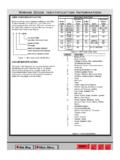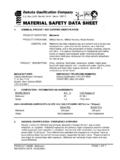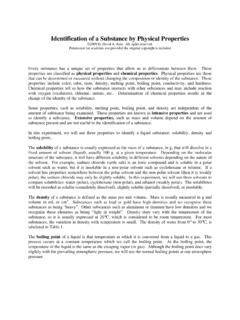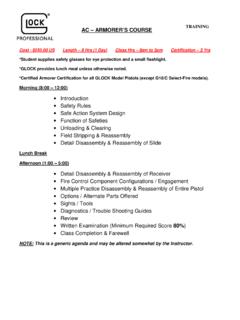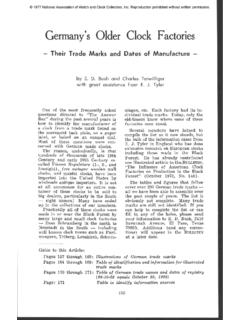Transcription of CHAPTER VI COMBAT IDENTIFICATION
1 CHAPTER VI. COMBAT IDENTIFICATION . A. DESCRIPTION. COMBAT IDENTIFICATION (CID) is the process of attaining an accurate characterization of entities in a combatant's area of responsibility to the extent that high-confidence, real-time appli- cation of tactical options and weapon resources can occur. The objective of CID is to maximize COMBAT /mission effectiveness while reducing total casualties (due to enemy action and fratricide). B. OPERATIONAL CAPABILITY ELEMENTS. forces must be able to positively identify all targets in the battlespace for all COMBAT mission areas air to air, air to surface, surface to surface, and surface to air. Surface includes land, sea, and subsurface otherwise known as ground and maritime (Figure VI 1). The CID. need is essential in order for commanders to effectively field, at any time, fighting forces that can rapidly and positively identify enemies, friends, and neutrals in the battlespace; manage and control the battle area; optimally employ weapons and forces; and minimize total casualties.
2 AWACS Commercial Aircraft E2-C. Surveillance COOPERATIVE. ENGAGEMENT CV-Launched Strike Merchant Ships CV Battle Group Joint Amphibious Group TBM. Battle Group Attacks Enemy Jamming Enemy Enemy Coastal Ground- Launched Enemy Ship Attack Missiles Air Attack Enemy Returning Helo CV Strike Aircraft Enemy Sub USAF COMBAT COMBAT ASCM Attack Aircraft USA Land Air Patrol COMBAT Force Figure VI 1. Concept COMBAT IDENTIFICATION VI 1. JOINT WARFIGHTING SCIENCE AND TECHNOLOGY PLAN. In 1992, the Joint Requirements Oversight Council (JROC) validated the Joint Mission Need Statement (MNS), which describes the broad-based requirements for CID. The JROC re- validated the MNS in 1998. These include positive, timely, and reliable IDENTIFICATION of friends, foes, and neutrals; classification of foes by class, type, and nationality; and interoperability re- quired among the military and desired with allied nations. The challenges presented by the requirements necessitate a CID architecture that blends both nonmateriel and materiel solutions.
3 Nonmateriel solutions include doctrine; tactics, techniques, and procedures (TTP); and training. From a cost perspective, the nonmateriel solution to resolving a CID deficiency is com- pelling if it does not carry untenable constraints on the warfighter. However, nonmateriel solu- tions often need to be augmented by materiel solutions. These can be characterized as coopera- tive/noncooperative sensor systems and command, control, and communications (C 3 ) systems . in particular, digital datalinks and radios, each of which contributes a portion to the CID solution. As such, CID is viewed as a capability, not a single system or program. A system-of-systems . approach is required. CID is the result of a process that appropriately and accurately characterizes the entities present in a combatant's area of responsibility. Effective CID can take place with varying de- grees of target IDENTIFICATION , depending on the conditions of the battlespace. At times, the extent of required IDENTIFICATION is only to rapidly distinguish among friendly, neutral, and adversary forces with high enough confidence to support weapon employment decisions.
4 At other times, IDENTIFICATION of target class ( , cruise missile, fighter, or bomber) or target recognition ( , target vs. decoy) is required to select the correct defensive or offensive tactical weapon response. In other cases, a more extensive characterization that identifies specific target parameters, such as platform type ( , MiG 29 vs. MiG 21) and intent ( , an active interceptor vs. a defector), is required to select optimal defensive weapons and to support weapon release decisions. In all cases, the goal for CID is to provide the necessary level of IDENTIFICATION to make correct weapon decisions. This CID approach supports the attainment of military objectives while minimizing total casualties. The primary objective for CID is to correlate and assign a foe, friend, or neutral identifi- cation label to a target. The IDENTIFICATION label can be assigned at any time from initial detec- tion of the potential target to weapon employment. To be useful for a direct-fire engagement, the correct target label must be correlated to a sensor return that is in a weapon sight ( , radar, laser, or thermal sight).
5 Indirect-fire weapons or supporting-fire weapons operate from a different perspective as they cannot see the target. The IDENTIFICATION is made and sent to the weapon by the fire requester or a surveillance/reconnaissance platform; the weapon is correlated to the specified target position. As discussed earlier, there are two classes of materiel solutions: Sensors the target is characterized either noncooperatively ( , radar signal modulation, high-range resolution radar, or electronic support measures) or coopera- tively ( , MK XII IDENTIFICATION friend or foe (IFF) system or Battlefield COMBAT IDENTIFICATION System (BCIS)). VI 2. COMBAT IDENTIFICATION C3 ( particularly digital datalinks and radios) the target declares (either periodically or when queried) its IDENTIFICATION and position in a reference frame that the shooter . can correlate with its own weapon and sensor system ( , Link 16). Additionally, C3 systems are a medium for passing ID information from other sensors or sources.
6 Both approaches have their strengths and limitations. If an offboard sensor performs the interrogation and IDENTIFICATION , there is the added necessity to pass and correlate the required information in a timely fashion. This requirement to correlate an IDENTIFICATION label with a sen- sor return in the weapon sight is a key discriminator and a source of significant cost for the systems. The vision is a fielded CID capability that ensures that all combatant platforms will have available the required IDENTIFICATION information in a timely fashion that is commensurate with the range and lethality of the platforms' weapons and sensors. The approach toward realizing this vision is through an integrated CID architecture that combines noncooperative and cooperative IDENTIFICATION sensors and systems with C3 ( particularly digital datalinks and radios) capabilities. Such architecture supports the development of situational awareness the overall, general knowledge of the tactical battlefield environment, including the location of friendly, neutral, and enemy forces as well as the plan of action for battle.
7 The required operational capability will then be achieved by combining onboard data from multiple sensors and systems with indirectly sup- plied offboard information. Due to the fundamental differences of their operating environments, the operational ca- pability elements can be aggregated into three categories: air, ground, and maritime target plat- forms. Air platforms are more dispersed, move at much higher speeds, and are engaged at rela- tively long ranges with imaging or nonimaging sensors. Ground platforms are closely spaced, move slowly, and are engaged at close ranges also with imaging and nonimaging sensors. Mari- time platforms are relatively slow compared with air platforms, can be either closely spaced (several hundreds of yards) or dispersed (several nautical miles), and are engaged at longer ranges than ground platforms due to the nonimaging sensors indigenous to the maritime platform or the imaging/nonimaging sensors of the aircraft attached to the maritime unit.
8 In general, the current CID capability against all platforms must be improved. The cur- rent CID capability in many cases does not allow for maximum use of a weapon's range and en- gagement of targets in highly mixed, fast-moving environments. Confining rules of engagement and necessary procedures and precautions often restrict COMBAT effectiveness. For ground targets (air-to-surface and surface-to-surface mission areas), the current capability is extremely limited. The plan is to have an initial level of high-confidence CID capability fielded for all early- deploying, first-line combatant platforms within 10 years. The CID capability must provide the required IDENTIFICATION information with very high confidence. For air targets (surface-to-air and air-to-air mission areas) as well as maritime targets (surface-to-surface and air-to-surface mission areas), CID needs improvement in some areas. In some cases, effective systems have been developed that could fill some of the needs but are not widely fielded.
9 In other cases, noncooperative sensor/technique databases need to be updated and more fully populated. In still other areas, correlation/fusion issues need to be resolved. The ob- jective is to provide nearly perfect IDENTIFICATION information. VI 3. JOINT WARFIGHTING SCIENCE AND TECHNOLOGY PLAN. The term automatic target recognition (ATR) is usually associated with the development or implementation of cooperative and noncooperative sensor systems for surface targets. The need for ATR systems stems from the increased complexity of tactical and strategic battlespaces, the unprecedented amount of raw information produced by modern sensor systems, and the ef- fectiveness of C3 systems. Collectively these can overwhelm the capability of human operators and decision makers. The magnitude and rate of information produced may exceed the operator's ability to absorb and process it in a timely fashion; performance declines with operator fatigue and varies with operator training. Consequently, ATR systems are being developed to provide an assortment of technological services that range from operator prompting (cueing) tools to fully automated recognition systems requiring no human operator intervention.
10 More precisely, the goal of ATR is to support rapid and reliable detection, geolocation, tracking, recognition, and prioritization of targets. In general, the output will provide a human operator or decision maker with target recommendations, weapon options, and the level of confi- dence associated with each proposed action. The degree to which the constituent functions can or should be automated depends not only on the efficacy of the ATR technology but also on sensor performance, target complexity and density, target environment, mission requirements, and required response times. For exa m- ple, particular mission or battlespace conditions may only require an ATR system to sort through a very large potential target density and alert an operator to the presence and location of a change in battlespace conditions ( , deployment of troop positions or bomb damage assessment) since the previous battlespace analysis. In this example, image analysts would be required to infer ap- propriate information from the data; such systems, which are predicated on active human partici- pation, are sometimes referred to as assisted target recognition or aided target recognition.



